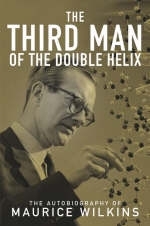
The Third Man of the Double Helix
Seiten
2004
Oxford University Press (Verlag)
978-0-19-860665-9 (ISBN)
Oxford University Press (Verlag)
978-0-19-860665-9 (ISBN)
- Titel ist leider vergriffen;
keine Neuauflage - Artikel merken
Working with Watson and Crick on the structure of DNA was a third man, Now in his 80s, Maurice Wilkins marks the 50th anniversary of the discovery of the Double Helix by telling, for the first time, his own story of the discovery of the DNA structure and his relationship with Rosalind Franklin, his co-worker, who died in 1958.
Francis Crick and Jim Watson are well known for their discovery of the structure of DNA in Cambridge in 1953. But they shared the Nobel Prize for the discovery of the Double Helix with a third man, Maurice Wilkins, a diffident physicist who did not enjoy the limelight. He and his team at King's College London had painstakingly measured the angles, bonds, and orientations of the DNA structure - data that inspired Crick and Watson's celebrated model - and they then spent many years demonstrating that Crick and Watson were right before the Prize was awarded in 1962. Wilkins's career had already embraced another momentous and highly controversial scientific achievement - he had worked during World War II on the atomic bomb project - and he was to face a new controversy in the 1970s when his co-worker at King's, the late Rosalind Franklin, was proclaimed the unsung heroine of the DNA story, and he was accused of exploiting her work. Now aged 86, Maurice Wilkins marks the fiftieth anniversary of the discovery of the Double Helix by telling, for the first time, his own story of the discovery of the DNA structure and his relationship with Rosalind Franklin.
He also describes a life and career spanning many continents, from his idyllic early childhood in New Zealand via the Birmingham suburbs to Cambridge, Berkeley, and London, and recalls his encounters with distinguished scientists including Arthur Eddington, Niels Bohr, and J. D. Bernal. He also reflects on the role of scientists in a world still coping with the Bomb and facing the implications of the gene revolution, and considers, in this intimate history, the successes, problems, and politics of nearly a century of science.
Francis Crick and Jim Watson are well known for their discovery of the structure of DNA in Cambridge in 1953. But they shared the Nobel Prize for the discovery of the Double Helix with a third man, Maurice Wilkins, a diffident physicist who did not enjoy the limelight. He and his team at King's College London had painstakingly measured the angles, bonds, and orientations of the DNA structure - data that inspired Crick and Watson's celebrated model - and they then spent many years demonstrating that Crick and Watson were right before the Prize was awarded in 1962. Wilkins's career had already embraced another momentous and highly controversial scientific achievement - he had worked during World War II on the atomic bomb project - and he was to face a new controversy in the 1970s when his co-worker at King's, the late Rosalind Franklin, was proclaimed the unsung heroine of the DNA story, and he was accused of exploiting her work. Now aged 86, Maurice Wilkins marks the fiftieth anniversary of the discovery of the Double Helix by telling, for the first time, his own story of the discovery of the DNA structure and his relationship with Rosalind Franklin.
He also describes a life and career spanning many continents, from his idyllic early childhood in New Zealand via the Birmingham suburbs to Cambridge, Berkeley, and London, and recalls his encounters with distinguished scientists including Arthur Eddington, Niels Bohr, and J. D. Bernal. He also reflects on the role of scientists in a world still coping with the Bomb and facing the implications of the gene revolution, and considers, in this intimate history, the successes, problems, and politics of nearly a century of science.
Maurice Wilkins is Emeritus Professor at King's College London, and shared the 1962 Nobel Prize for Physiology or Medicine with Crick and Watson for the discovery of the double helical structure of DNA.
Preface; List of plates; 1. Distant shores; 2. Finding my feet; 3. In a world at war; 4. Randall's circus; 5. Crystal genes; 6. Go back to your microscopes!; 7. How does DNA keep its secrets?; 8. The double helix; 9. Living with the double helix; 10. A broader view; Index
| Erscheint lt. Verlag | 1.1.2004 |
|---|---|
| Zusatzinfo | 24pp halftone plates |
| Verlagsort | Oxford |
| Sprache | englisch |
| Themenwelt | Literatur ► Biografien / Erfahrungsberichte |
| Sachbuch/Ratgeber ► Natur / Technik | |
| Naturwissenschaften ► Biologie ► Genetik / Molekularbiologie | |
| Naturwissenschaften ► Physik / Astronomie ► Angewandte Physik | |
| ISBN-10 | 0-19-860665-6 / 0198606656 |
| ISBN-13 | 978-0-19-860665-9 / 9780198606659 |
| Zustand | Neuware |
| Haben Sie eine Frage zum Produkt? |
Mehr entdecken
aus dem Bereich
aus dem Bereich
50 Meilensteine der Genetik
Buch | Hardcover (2022)
Librero b.v. (Verlag)
CHF 13,90


